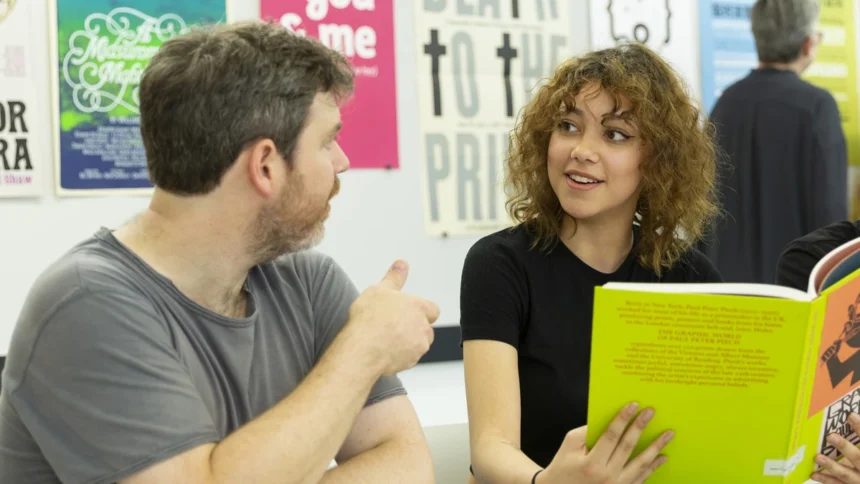Introduction of MA Type Design Reading
The world of type design is a fascinating blend of artistry and technology, rooted in centuries of tradition but always evolving with the latest design and technological trends. With the increasing demand for unique, readable, and aesthetically pleasing typefaces, many designers are turning to specialized courses, such as an MA in Type Design, to develop their skills.
One of the most well-regarded programs is the MA Type Design Reading at the University of Reading in the UK, which offers students a comprehensive curriculum that covers both theoretical and practical aspects of typeface creation. In this article, we will explore the key concepts that underpin type design and why the MA Type Design Reading program is a top choice for aspiring type designers.
Understanding Type Design
Before diving into the specifics of the MA Type Design Reading program, it’s essential to understand the basics of type design itself. Type design is the process of creating a set of characters, known as a typeface, that can be used for printing or digital text. A typeface consists of letters, numbers, and symbols designed with consistent visual features. Typeface creation requires a balance between artistic expression and functional legibility.
The History of Type Design
The roots of type design go back to the invention of movable type by Johannes Gutenberg in the 15th century. Since then, type design has evolved dramatically, with designers like Claude Garamond, John Baskerville, and Adrian Frutiger leaving indelible marks on the craft. The history of type design is a rich narrative of technological advancements, cultural shifts, and aesthetic movements. Each new phase brought about changes in how typefaces were created and used, from the calligraphic styles of the Renaissance to the digital fonts of the modern era.
In the context of the MA Type Design Reading program, students are encouraged to study the historical trajectory of typography to understand how past influences shape current design practices. This historical knowledge enables them to create typefaces that are both innovative and grounded in tradition.
The Art and Science of Typeface Creation
Type design is often referred to as the art of balancing form and function. While aesthetics play a critical role, legibility and readability are paramount. A well-designed typeface must not only look appealing but also ensure that the text is easy to read in different sizes, on various platforms, and for extended periods. This is where the science of type design comes in—understanding the nuances of letterforms, spacing, and kerning is vital for creating functional fonts.
Students in the MA Type Design Reading program learn to master this balance. They are instructed in letter form and proportion analysis, with an eye toward x-height—the height of lowercase letters—stroke thickness, and curvature.These elements must work in harmony to create a typeface that is cohesive, readable, and versatile.
MA Type Design Reading: A Comprehensive Program
The MA Type Design Reading program is one of the most prestigious and comprehensive courses available for aspiring type designers. Based at the University of Reading, this program offers an in-depth exploration of type design, blending theoretical study with practical application. Here’s a closer look at what the course entails and why it stands out in the world of type design education.
Curriculum Overview
The MA Type Design Reading program covers a wide range of topics, from the history of typography to the latest digital design tools. The curriculum is designed to give students a well-rounded education in type design, ensuring they leave the program with both creative and technical skills.
1. History and Theory of Typography
One of the key components of the MA Type Design Reading program is its emphasis on the historical and theoretical aspects of typography. Students delve into the origins of type, studying the major typefaces and typographic styles that have shaped the design world. This historical foundation is crucial for understanding the evolution of type and how it can be reinterpreted for modern use.
2. Letterform Design and Development
Students are trained in the art of letterform design, learning how to create individual characters that are both visually appealing and functional. This process involves understanding the anatomy of type, from the baseline to the ascender line, and learning how to design letters that are both harmonious and distinct.
3. Digital Typeface Design
In today’s digital age, type design has moved far beyond hand-drawn letters and metal type. The MA Type Design Reading program places a strong emphasis on digital typeface creation, teaching students how to use industry-standard software like FontLab, Glyphs, and Robofont. Students learn to digitize their designs and fine-tune them for use in different media, from print to web to mobile apps.
4. Research and Analysis
A unique aspect of the MA Type Design Reading program is its focus on research and analysis. Students are encouraged to engage in academic research, analyzing existing typefaces, studying the legibility of fonts in different contexts, and exploring how type design can be used to solve real-world communication problems. This research component helps students develop a deeper understanding of the role of typography in society and equips them with the skills needed to create typefaces that are both innovative and functional.
5. Professional Practice
To prepare students for careers in type design, the MA Type Design Reading program includes a professional practice module. This module covers topics like font licensing, intellectual property, and client relationships, ensuring that students are well-prepared to enter the professional world. Students also have the opportunity to work on real-world projects, gaining hands-on experience that will serve them well in their future careers.
Key Benefits of the MA Type Design Reading Program
Expert Faculty
The MA Type Design Reading program is taught by some of the leading experts in the field, including renowned type designers, typographers, and historians. This guarantees students receive first-rate instruction and mentoring.
State-of-the-Art Facilities
The University of Reading is equipped with cutting-edge design studios and workshops, allowing students to experiment with different materials and tools in both traditional and digital type design.
Global Reputation
The program is internationally recognized for its excellence, with graduates going on to work for some of the biggest names in design and publishing, including Adobe, Google, and Monotype. The University of Reading’s MA Type Design Reading course is known for producing well-rounded, highly skilled designers.
Networking Opportunities
With guest lectures from industry professionals and opportunities to collaborate with peers and professors, students in the MA Type Design Reading program can build valuable connections that will serve them throughout their careers.
Why Choose MA Type Design Reading?
The MA Type Design Reading program stands out for several reasons. It offers a balanced blend of theoretical and practical learning, ensuring that students not only develop creative skills but also understand the technical aspects of type design. Finally, the program’s strong industry connections and emphasis on professional practice mean that graduates are well-prepared to enter the competitive world of type design.
Key Concepts in MA Type Design Reading
Now that we’ve explored the structure of the MA Type Design Reading program, let’s take a closer look at some of the key concepts students will encounter.
1. Anatomy of Type
The anatomy of type is among the first lessons MA Type Design Reading students will pick up. This covers knowing the several components of a letter—that is, the x-height, baseline, cap height, ascender, descender, and counter. Designed coherent typefaces depend on these components since they guarantee that every letter corresponds in terms of proportion and spacing with the others.
2. Kerning and Tracking
Tracking describes the space between groups of letters; kerning describes the space between individual letters. These both are absolutely essential for producing readable typefaces. Students in the MA Type Design Reading program learn how to change kerning and tracking to guarantee that text—especially in extended passages—is easily readable.
3. Contrast and Stress
Stress is the direction of the difference in thickness between the thick and thin portions of a letter; contrast is that difference. The general impression of a typeface is strongly influenced by both of these components. A low-contrast typeface will seem more laid-back and approachable; a high-contrast typeface will have a more dramatic and formal look.
4. Serif vs. Sans-Serif
Serif typefaces have small lines or strokes attached to the ends of letters, while sans-serif typefaces do not. Both styles have their own unique characteristics and uses. In the MA Type Design Reading program, students explore both styles and learn how to design their own serif and sans-serif typefaces.
5. Legibility vs. Readability
While readability describes how easily one may read text set in a typeface, legibility describes how easily one may recognize individual characters in that typeface. Creating functional typefaces depends on both, hence students in the MA Type Design Reading program learn how to balance these two components to produce fonts that are both aesthetically beautiful and useful.
FAQ Section
1. What is the MA Type Design Reading program?
The MA Type Design Reading program is a postgraduate course at the University of Reading that focuses on the study and creation of typefaces. The program covers both historical and modern aspects of type design, offering students a comprehensive education in typography.
2. What are the entry requirements for the MA Type Design Reading program?
Usually, applicants have a bachelor’s degree in graphic design, typeography, or a similar discipline. Additionally needed is a portfolio of work to show your aptitudes in type design.
3. What software is used in the MA Type Design Reading program?
Students in the MA Type Design Reading program use industry-standard software like FontLab, Glyphs, and Robofont for digital typeface design.
4. How long does the MA Type Design Reading program take to complete?
Typically, one year is required to complete the program on a full-time basis.
5. What career opportunities are available after completing the MA Type Design Reading program?
Graduates of the MA Type Design Reading program can work as type designers, graphic designers, typographers, and font developers. Many alumni work for major design firms, publishing companies, or start their own type foundries.
Conclusion
Aspiring type designers have a special chance in the MA Type Design Reading program to hone their abilities in one of the most esteemed courses available worldwide. The program gives students the tools they need to excel in the competitive field of type design by combining historical knowledge with contemporary technologies. The MA Type Design Reading program is a great approach to increase your knowledge and experience whether your interests are in designing new fonts or in learning more about typeography.










